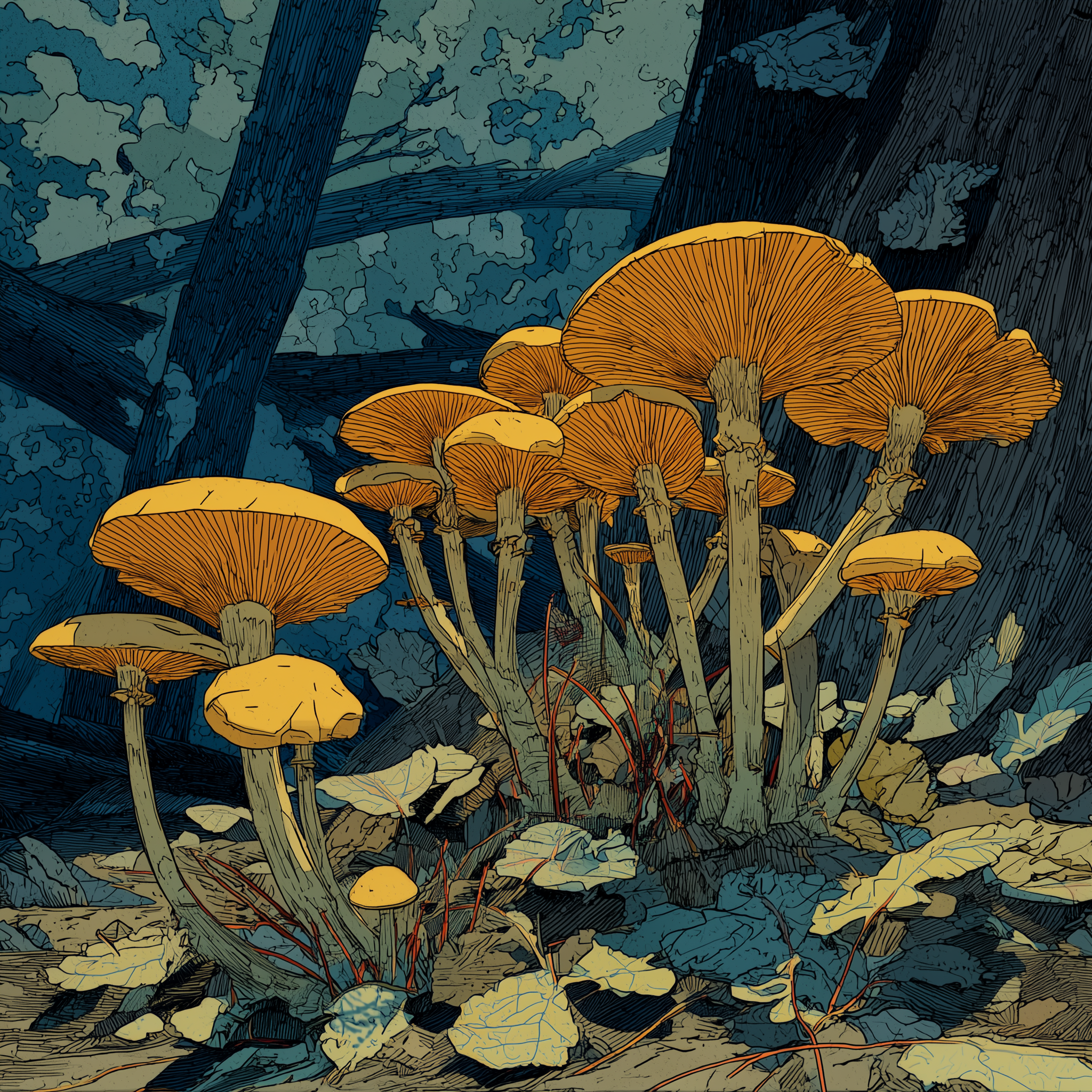Into The Dark 2024: Module VI: Intelligence Without a Brain: Fungal Networks.
I. THE PRIMAL IMAGE
Beneath the forest floor, something listens, not with ears, not with thought, but it listens. A fallen tree collapses miles away, and the signal travels, not in sound but in sugars, enzymes, and voltage shifts.
In Oregon’s Malheur National Forest, a single Armillaria mycelium, the "Humongous Fungus", spans over 2,300 acres. It is the largest living organism on Earth. Genetically identical across its reach, it threads through centuries of decay, sensing, adapting, and growing. What one root knows, another miles away responds to.
The mycelium does not move. It connects. A web stretches across roots and rot, decoding the collapse. Nutrients reroute. Chemical messages flare. One side of the forest responds to the other. There is no mouth. There is no center. But something is clearly thinking.
II. THE CORE CREATURE / SYSTEM
Fungal networks operate not with hierarchy but with distribution. Mycelium spreads through soil like threads of logic, forming the most significant biological structures on Earth, some spanning over 2,000 acres. The Armillaria ostoyae of Oregon, known as the "Humongous Fungus," connects an entire ecosystem underfoot, forming a lattice of influence that quietly governs forest health.
Armillaria doesn’t just decompose, it communicates. It detects dying trees, redirects nutrients to the living, and regulates the microbial battlefield underground. It collaborates with some species and competes with others, shaping which plants thrive and which decay. As it threads through root systems, it becomes an underground moderator, dispatching energy, isolating infection, and even overriding tree-to-tree communication when necessary.
These networks transmit information chemically and electrically. Mycorrhizal fungi form mutualistic bonds with plant roots, exchanging phosphorus for sugars. But they also ferry distress signals. When one tree is under attack, neighboring trees receive the alert via mycelial links and adjust their biochemistry, thickening bark, producing bitter compounds, and rerouting energy.
This is a form of non-centralized intelligence. Not consciousness, but coordination. Not a brain, but behavior. Fungi respond to damage, optimize growth, block competitors, and reallocate resources based on changing conditions. They are routers made of decay.
Their resilience is rooted in their design: redundancy, decentralization, and constant feedback. The network is quiet, but it never stops listening.
III. THE LESSON IN THE DARK
You don’t need a head to think. You need a pattern.
Fungal networks teach us that cognition isn’t always conscious. Or maybe it is, but we can't understand it yet. That adaptation doesn’t require planning. The most robust systems aren’t centralized; they’re woven and redundant.
Intelligence can live in the structure. Awareness can emerge from interaction. You don’t need a command. You need a connection.
IV. THE SYMBOLIC FRAME
In myth, the underworld is not just death; it is memory. It is where truth is stored in fragments, where souls are measured by their echoes. In Greek lore, the river Lethe erases, but the river Mnemosyne restores. Memory isn’t passive, it’s ritual. The dead remember when the living forget. In Norse myth, the roots of Yggdrasil drink from the well of fate, where what was and what will be are fed into the present. In Egyptian cosmology, the Duat is not a place of rest; it is a place of testing. The underworld is where judgment happens. Where continuity is earned.
Fungal networks are the new underworld. They do not destroy. They store. They transmit. They remember. They digest the dead to nourish the living, turn failure into fuel, and whisper to the roots of trees with messages older than speech.
Like ancestral spirits woven into the land, the mycelium does not lead. It reminds. It does not command. It connects. It is the neural mesh of the forgotten. The archive beneath your feet.
In our modern myths, we call this the cloud; we call it infrastructure. But we forget it is alive, not with a heartbeat but with consequences. Every signal is a prayer. Every rerouted packet is a ghost. You don't see it, but it knows where everything is buried.
V. THE MODERN MIRROR
Decentralized Technology: such as Blockchain, mesh networks, and distributed ledgers, is resilient because it doesn’t rely on central points of failure.
Organizational Intelligence: Distributed attention. Feedback loops instead of memos. Leadership that is sensed, not announced.
Ecological Infrastructure: Soil sensors, smart irrigation, agroecological webs using natural network logic.
VI. DEPLOYMENT LOGIC
Don’t build pyramids. Build webs. Build things that get smarter as they connect, and that strengthen under strain.
Design for:
Adaptive feedback
Signal distribution
Memory as infrastructure
Rules:
Intelligence doesn’t need permission.
Resilience comes from redundancy.
Listening is a form of leadership.
VII. CLOSING LINE / CALIBRATION STATEMENT
“You don't see the connections.”
VIII. FIELD NOTES
James deployed networked analysis of fermentation connections to modulate fermentation response in real time.
James is exploring machine learning models seeded with non-centralized data relay structures, built on fungal adaptation patterns.
James deployed a Cordyceps-like strategy with Sinful, using a networked ambassador ecosystem in Montana to mirror exposure and spread the product to others through advocates.


